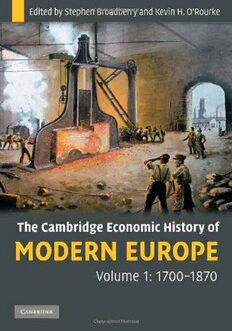
The Cambridge Economic History of Modern Europe: Volume 1, 1700-1870 PDF
345 Pages·2010·6.176 MB·English
Most books are stored in the elastic cloud where traffic is expensive. For this reason, we have a limit on daily download.
Preview The Cambridge Economic History of Modern Europe: Volume 1, 1700-1870
Description:
This is an example of the «Cambridge history» approach at its best. The 140 years between 1870 and 2010 is broken into three periods: those of globalization (1870-1913), the world wars and their aftermath (1914-1950), and post-war (1951- ). Within each period noted experts present a series of topical treatments, which are tied together well, with considerable cross-referencing. The positions taken are well supported and clearly presented, and extensively cross-referenced. The result is quite coherent and readable. A great deal of valuable data is presented in tabular form.The first volume is centred on the transition to modern economic growth, which first occurred in Britain before spreading to other parts of western Europe by 1870. Each chapter is written by an international team of authors who cover the three major regions of northern Europe, southern Europe, and central and eastern Europe. The volume covers the major themes of modern economic history, including trade urbanization aggregate economic growth the major sectors of agriculture, industry and services and the development of living standards, including the distribution of income. The quantitative approach makes use of modern economic analysis in a way that is easy for students to understand.The second volume tracks Europes economic history through three major phases since 1870. The first phase was an age of globalization and of European economic and political dominance that lasted until First World War. The second, from 1914 to 1945, was one of war, deglobalization, and depression and the third was one of growing integration not only within Europe but also between Europe and the global economy. Leading authors offer comprehensive and accessible introductions to these patterns of globalization and deglobalization as well as to key themes in modern economic history such as economic growth, business cycles, sectoral developments, and population and living standards.
See more
The list of books you might like
Most books are stored in the elastic cloud where traffic is expensive. For this reason, we have a limit on daily download.
